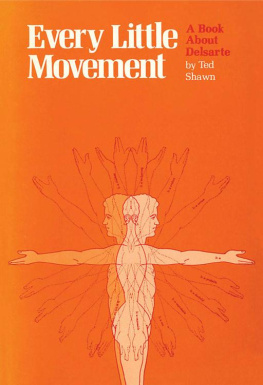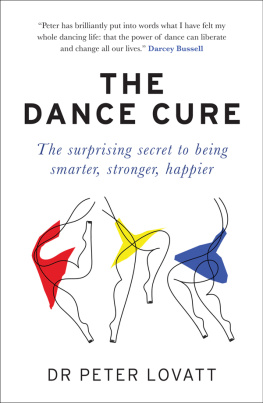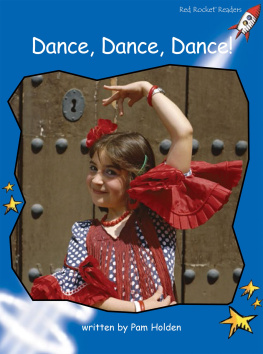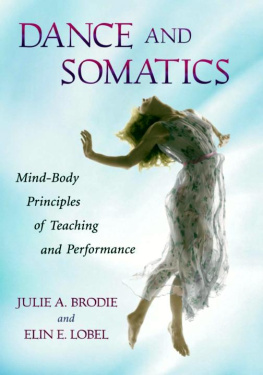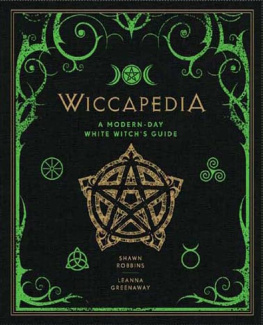


This book is dedicated to
The Master | F RANOIS D ELSARTE |
and to my teacher | M RS . R ICHARD H OVEY |
and I wish to thank:
Louise Gifford, of the Drama Department of Columbia University for reading the manuscript, making valuable suggestions, and for writing the introduction to this book.
Lucien Price, of the Boston Globe
Walter Terry, of the New York Herald Tribune
Carol Stone, actress and disciple of Delsarte
Ed Menerth, of the drama department of Miami University
Joseph E. Marks, III
John Christian
all of whom read the manuscript and made valuable suggestions.
Virginia Butterfield, who not only read the manuscript, but read printers proof for me.
Madame Hlne Poitier de la Housaye
Pauline Lawrence Limon
Doris Humphrey
Genevieve Oswald, Dance Archives Curator, New York Public Library
Juana
Mrs. Clarice Burrell
all of whom helped me to secure access to valuable source material.
La Meri, who for three successive years invited me to give a series of lectures on Delsarte at her Ethnologic Dance Center in New York.
Copyright, 1954, by Ted Shawn. Every Little Movement copyright 1910 by M. Witmark & Sons, copyright renewed. The quotation from Every Little Movement is used by the gracious permission of M. Witmark & Sons, and Otto Harbach who wrote the lyrics of Madam Sherry.
This is an unabridged republication of the Second Revised and Enlarged Edition published in 1963 by the Author, and is one of a series of republications by Dance Horizons/Princeton Book Co., Publishers, POB 57, Pennington, NJ 08534. Library of Congress Catalog Card No. 68-28049. ISBN 0-87127-015-3. Printed in the United States of America.
Third printing 1988
TABLE OF CONTENTS
Preface To The Second Edition
As was said in the first edition of EVERY LITTLE MOVEMENT the only missing important source work at the time of publication was the book by Alfred Giraudet, published in Paris in 1895, under the title MimiquePhysionomie et Gestes; Methode Pratique dapres le systeme de F. Del Sarte. Pour servir a lexpression des sentiments. While there is reason to believe an English translation was made and published in this country by Edgar S. Werner, search by me, aided by a number of friends, has failed to track down a copy. The French edition in the Boston Public Library was briefly studied by me, and then by having a micro-film made, and having this printed on paper, same size as the original book, by Xerox process, and having this translated into English for me by Mrs. Virginia Butterfield, only within the last year, this second edition has finally been made possible.
There has been some revision of the text of the first edition, and I have added as No. XII in the Bibliography a summary and an evaluation of Giraudets book. My friend, William Thomas, working from the drawings of Gaston le Doux which illustrated Giraudets book, has provided me with six charts included in the second edition. Using the first edition of this book as a textbook with my own classes in Mime for nine years, I found that one of the areas of difficulty was that students found it hard to understand the chart of the nine-fold accord, since I had given that chart only in its abstract form. These added charts show how this principle is applied to attitudes of the head, stances of the legs, positions, or expressive uses of the hand, etc. etc. I hope these charts will make it easier to understand the nine-fold accord.
Footnotes have been added to the original text of the first edition to enable the student to compare what I had given them as from Mrs. Hovey, Mrs. Stebbins, Mme. Arnaud and other sources with the same material as presented by M. Giraudet. Some other additions have been made to bring things up to date, such as the changed situation in Louisiana State University, as to the accessibility of the Delsarte material there.
I have been very gratified that this book has been of help not only to dancers and choreographers, but also has been used as a text book in the speech and drama departments of colleges and universities, and I have had many testimonies as to the diagnostic value of this science to psychiatrists and those working in personnel and guidance.
Ted Shawn
Jacobs Pillow
July, 1963.
Introduction
I AM SPEAKING OF TED SHAWN
By Louise Gifford
of the School of Dramatic Arts, Columbia University
Every artist should have it, but only the greatest will understand it. So said Richard Wagner, the composer.
Wagner was giving his appraisal of the then recent discoveries of Franois Delsarte, discoveries of the principles whereby man, through his body, gives form to feeling.
Have records been kept of these discoveries? Where are they to be found today? Has anyone ever really used them?
This book gives the answers to these questions: These records have been collected, preserved and used by Ted Shawn, whose accomplishments in art and education place him among our greatest. It is an accepted fact that Mr. Shawns vision, plus hard concentrated work, has been the greatest single factor in achieving the recognition of The Dance as an art form in its own right and as a dynamic educational force, worthy to be listed for study as an accredited academic subject.
Many years ago Mr. Shawn said, The art of the dance is too big to be encompassed by any one system, school or style. On the contrary, the Dance includes every way men of all races, in every period of the worlds history, have moved rhythmically to express themselves. To learn the dances of many races is to learn to love the peoples of many races. To this end, and because it needed to be done, Ted Shawn dreamed up and founded a University of the Dance. Here each season combinations of artists are brought for performing and teaching which can never be seen or met anywhere else in the world. Here students from far and wide can study and learn as nowhere else in the world. That from the one universal feeling of good health with good will there springs endless diversity of rhythmic expressions called dance, a few have realized, and the educational and cultural value of this fact is constantly talked about. But Ted Shawn is the one who DID something about making such an educational experience possible.
This University of the Dance and the Jacobs Pillow Dance Festival, originated, managed and directed by him, is a success both artistically and economically. Have you ever tried to organize and run a school? Then you know what it takes. The success of this University alone would justify the quotation, Ted Shawn has an ineradicable place in the history of American culture.
As a concert artist Shawn has had top billing throughout America, Europe and the Orient. As a performer, his artistry is unexcelled. As a choreographer, his works have been revolutionary. It was he who gathered together a group of athletes, formed them into a company that played over 1250 performances to enthusiastic audiences in 750 cities in the United States, Canada, Cuba and England, and disbanded it in 1940, when, for the second time in his career, war and military service claimed him.
As a lecturer Ted Shawn keeps the close attention of his audiences by warmth of presentation, clarity and scholarship, plus the value of material offered. You have lectured? Then you know the study, care and preparation it takes.
Next page
